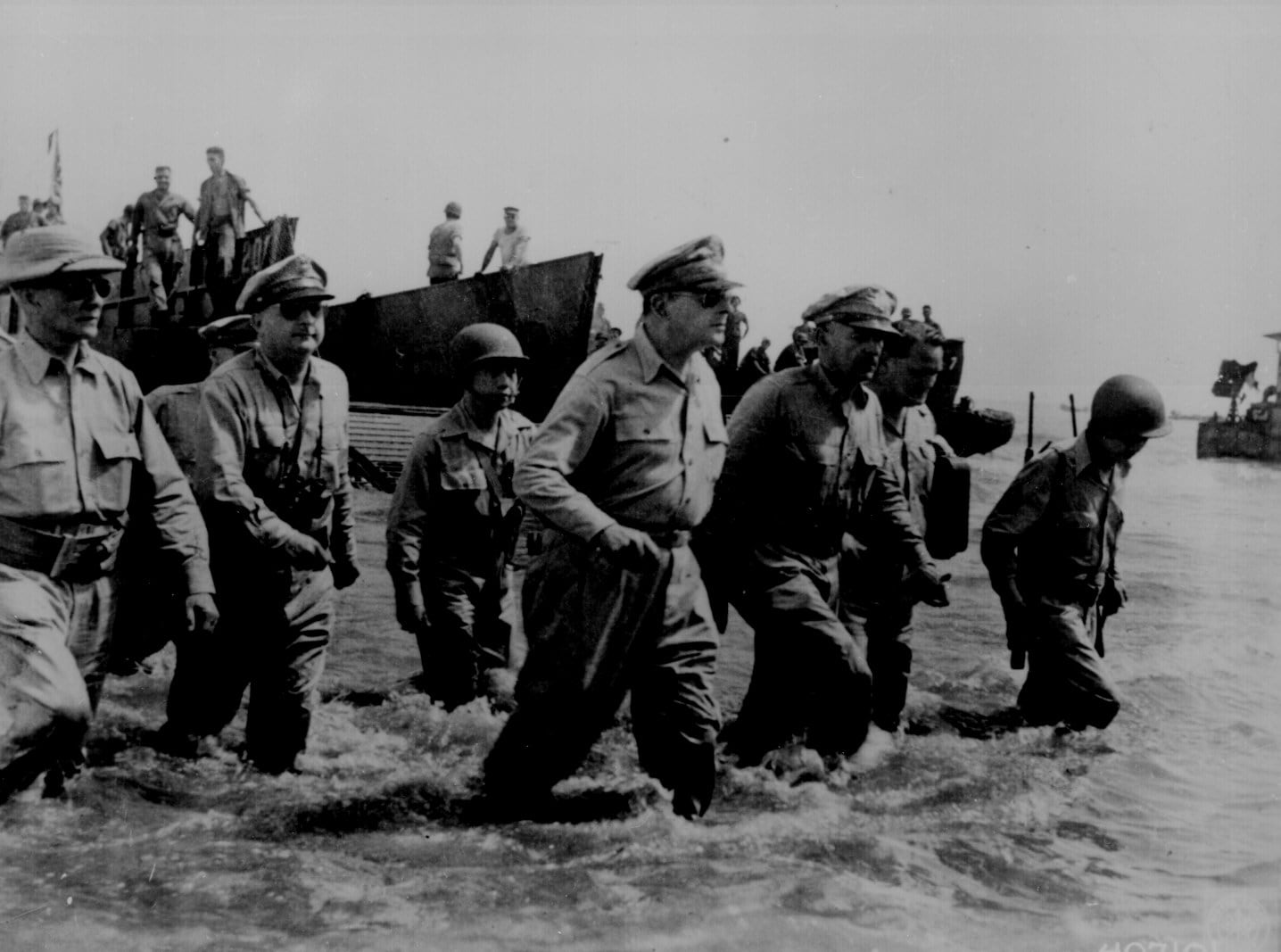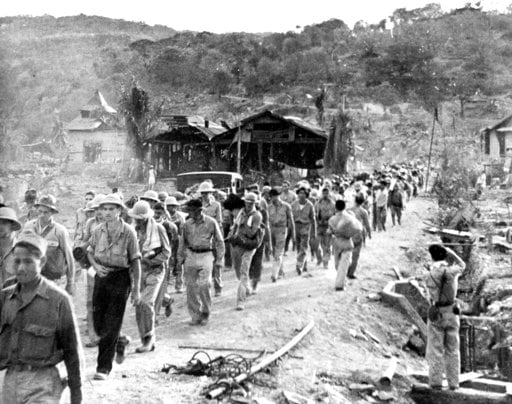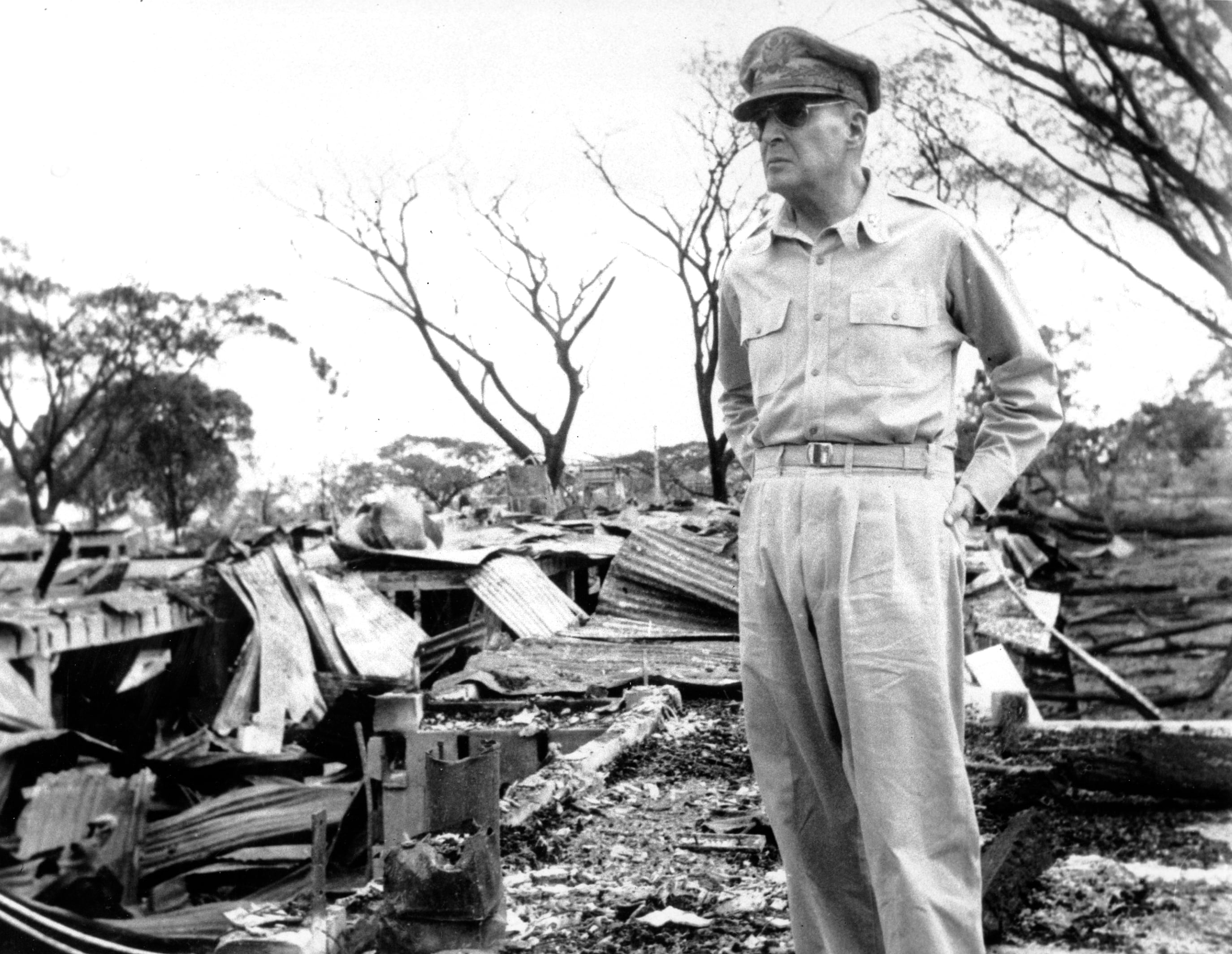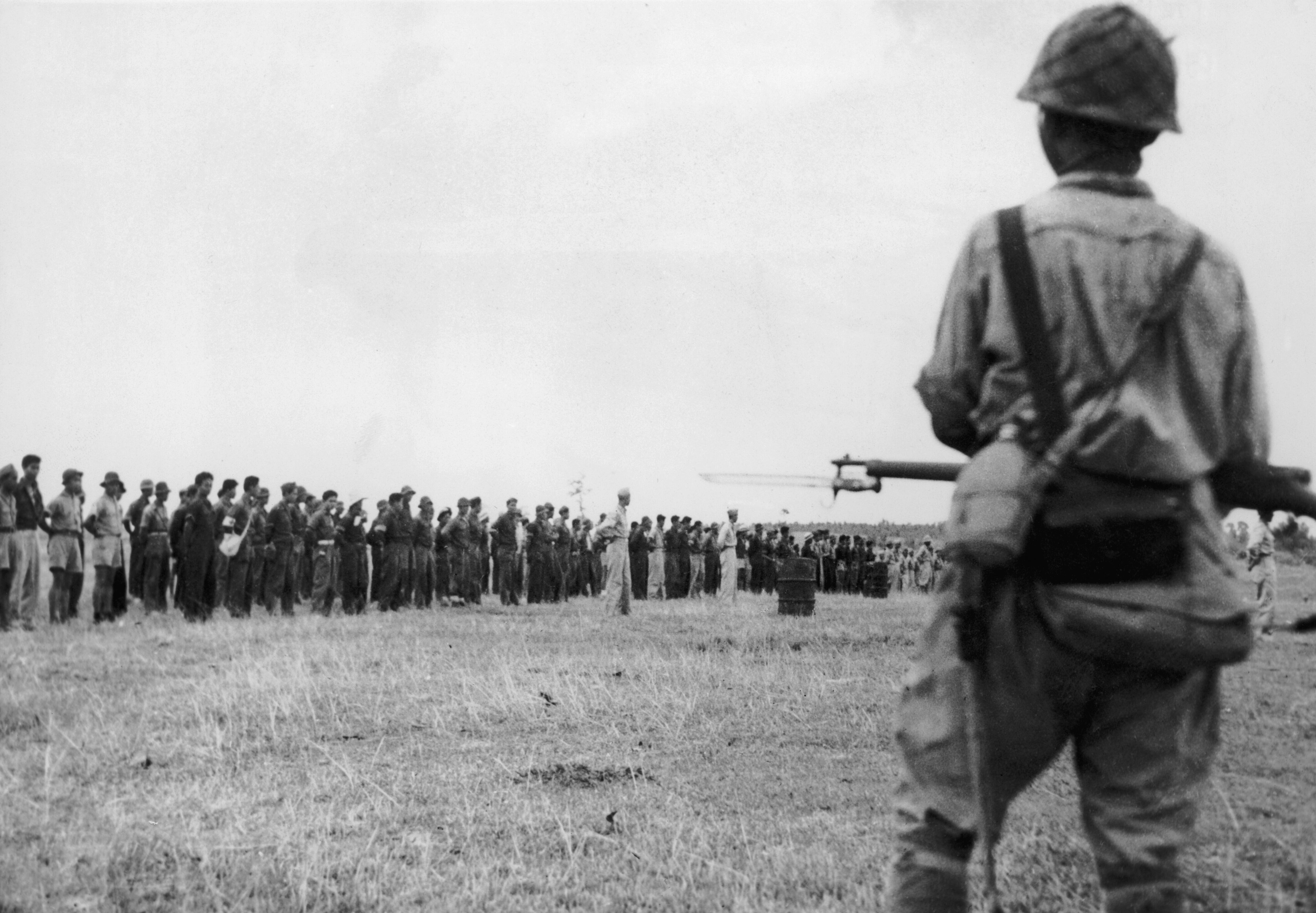This story was originally published Jan. 14, 2021, on HistoryNet.
Under orders from President Franklin Roosevelt on this day 80 years ago, famed Army Gen. Douglas MacArthur abandoned his island stronghold of Corregidor during his defense of the Philippines against the Japanese military invasion.
The general left behind a combined 90,000 U.S. and Filipino troops. Outmanned, outgunned and cut off from supplies, many would succumb to the Japanese push, some dying in the dreaded Bataan Death March and others held prisoner until the end of the war. MacArthur would famously return to the Philippines in October 1944, more than two years later, to liberate the islands and American troops still in captivity. Here’s the inside story on why MacArthur failed to act at a decisive moment in the war.
AT ABOUT 3:40 A.M. on December 8, 1941, the phone rang inside Lieutenant General Douglas MacArthur’s lavish apartment atop the Manila Hotel. It was MacArthur’s chief of staff, calling with the shocking news that the Japanese had attacked Pearl Harbor earlier that morning—December 7 across the international date line in Hawaii. MacArthur, commander of American forces in the Philippines, hastened to his headquarters, where his air chief arrived shortly thereafter with a request: Major General Lewis H. Brereton wanted permission to launch a bombing raid against Japanese bases in Formosa before the Japanese could strike Clark Field, the main American air base in the Philippines. Despite repeated appeals from Brereton, however, and even several minor Japanese air raids on the Philippines, nearly seven hours went by before MacArthur finally authorized the strike.
By then, it was too late.
At 12:30 p.m. Brereton’s B-17 Flying Fortresses were on the ground at Clark Field, being fueled and loaded with bombs for the Formosa mission, when 88 Japanese bombers and fighters attacked. Brereton’s B-17s were defenseless. Of the 17 on the ground at the time, 12 were destroyed and five were badly damaged. Not a single one was flyable. “It was a mess. Oil dumps and hangars were blazing fiercely. Planes were burning on the ground,” said Lieutenant William E. “Ed” Dyess, who surveyed the destruction below from the cockpit of his P-40 fighter plane. On the ground, things were as bad as they looked from above. Private Howard Watson saw “devastation and havoc all around,” and Lieutenant Colonel Ernest B. Miller noted the “dead and wounded…strewn about.” To Lieutenant Austin W. Stitt, “Everything everywhere seemed on fire and dead.”
Brereton’s heavy bombers were the linchpin of the Philippines’ planned defense—but in one stroke, Japan had obliterated that threat. Why MacArthur had held back and waited for the enemy to strike first was a mystery even to his colleagues. Army Chief of Staff George C. Marshall couldn’t fathom “how MacArthur happened to let his planes get caught on the ground,” and air force commander Henry H. “Hap” Arnold wrote in his 1949 memoirs that he never felt he got “the real story of what happened in the Philippines.” Historians and MacArthur biographers have debated ever since why MacArthur waited so long to authorize the Formosa raid.
The answer may lie in the close relationship—too close, perhaps—between the American commander and Philippine President Manuel L. Quezon.
EVER SINCE THE PHILIPPINES became an American possession in 1898, U.S. officials wondered how to defend it in case of war with Japan, a country thought to have an expansionist eye on the islands. The Philippines is 5,000 miles from Hawaii, which made reinforcement and resupply difficult, but fewer than 300 miles coast to coast from Japanese-held Formosa (now Taiwan). In 1934, defense of the Philippines became a short-term proposition when Congress voted to grant it independence in 1946.
In 1935, Philippine President Quezon—the overwhelming choice that year in the country’s first nationwide election—persuaded Washington to appoint outgoing U.S. Army Chief of Staff MacArthur as military adviser to the Philippines, to develop an army to protect it upon independence. Quezon and MacArthur had met in 1904 when MacArthur was a 24-year-old lieutenant fresh out of West Point and Quezon was a 26-year-old lawyer with political aspirations. Their friendship ripened into “remarkable intimacy,” the New York Times reported, when MacArthur was stationed in the Philippines during the 1920s. As military adviser, MacArthur continued to draw his U.S. Army salary while the Philippine government paid him a generous remuneration and provided him with an expense account and a penthouse apartment in Manila. When MacArthur retired from the army in 1937, Quezon appointed him field marshal of the Philippine Army.

Quezon was the driving political force in the islands, “one hundred and forty pounds of political and human dynamite,” in the words of a New York Times correspondent. To High Commissioner Francis B. Sayre, the senior U.S. official in the Philippines, Quezon was a man “of marked ability, and a consummate politician…a prima donna of the first order. Always he was adroit and dramatic.” An advocate of independence, Quezon proclaimed he would “rather live under a government run like hell by Filipinos than one run like heaven by Americans.” He was loyal to the United States, but he believed his primary duty was to his people. When American and Philippine interests diverged, he did not always willingly toe the American line.
Until 1946, the Philippines’ defense was America’s responsibility, and Quezon began to doubt that the United States could protect his country against Japan. In 1937 and 1938, he visited Tokyo, ostensibly on vacation, and felt out senior Japanese officials. The Japanese rolled out the red carpet, and Quezon even dined with Emperor Hirohito. “Japan has no aggressive intentions towards the Philippines. All we want is your trade,” Quezon remembered Japanese officials assuring him. They promised to respect Philippine neutrality once the islands became independent. This planted the seed in Quezon’s mind that Japan might spare his country in the event of war with the United States—an idea with long-term consequences.
AMERICAN OFFICERS shared Quezon’s doubts about their ability to defend the Philippines. “A troop of Boy Scouts flying kites could take these damned islands,” Major Kirtley J. Gregg complained in a letter to his wife in March 1941.
That was about to change, however, and the catalyst was the B-17 Flying Fortress, a four-engine bomber that could fly 2,400 miles while carrying two tons of bombs. These planes would bring “American power back into the Islands,” Secretary of War Henry L. Stimson proclaimed in September 1941. A fleet of heavy bombers in the Philippines might become “the decisive element in deterring Japan from undertaking a Pacific War,” army chief of staff Marshall believed. If war came, Philippine-based B-17s could hit Japanese bases on Formosa. Should Japan advance against Malaya and the Netherlands East Indies to seize the oil and other raw materials it desperately needed, B-17s could menace that advance. Marshall even envisioned Fortresses from the Philippines striking the Japanese home islands and landing in Vladivostok, Russia, to refuel and rearm.
The War Department planned to have 170 heavy bombers in the Philippines by October 1942. As of late November 1941, however, only 35 B-17s of the 19th Bombardment Group had arrived; 33 more Fortresses were expected in December and 51 in January. In an off-the-record press briefing, Marshall referred to the 35 B-17s already there as the greatest concentration of Flying Fortresses in the world.
As relations with Japan deteriorated, the army had recalled MacArthur to active duty on July 26, 1941, and put him in command of all American and Filipino troops in the islands. On November 27, Marshall warned MacArthur that war was imminent. If hostilities could not be avoided, “the United States desires that Japan commit the first overt act,” Marshall told him.
If war came, General Brereton planned to have his B-17s strike the air and naval bases in southern Formosa, about 500 miles north of Clark Field. By December 8, 1941, Brereton had the bombers split between two bases. Nineteen were at Clark Field on Luzon, the main Philippine island. The remaining 16 were at Del Monte Field on Mindanao, more than 500 miles south of Clark and safely out of range of Formosa-based planes.

Brereton learned of the Pearl Harbor attack at about 4 a.m. on December 8 when Lieutenant General Richard K. Sutherland, MacArthur’s chief of staff, woke him with the news. Brereton promised Sutherland that his bombers would be ready to hit Formosa at daybreak. He planned to have the B-17s at Clark Field strike Formosa immediately, then fly the Fortresses at Del Monte up to Clark for a second attack later that day.
At 5 a.m., Brereton went to MacArthur’s headquarters seeking permission to hit Formosa. Sutherland told Brereton that MacArthur was too busy to see him and that he was to prepare for an attack, but to await further orders before launching one. Thirty-five minutes later, Marshall sent MacArthur a radiogram ordering him to carry out tasks outlined in the current war plan, Rainbow 5, including “air raids against Japanese forces and installations within tactical operating radius of available bases.”
Brereton returned to MacArthur’s headquarters at 7:15 a.m., but Sutherland again refused to let him see MacArthur. Brereton renewed his request to bomb Formosa. Sutherland went into MacArthur’s office and returned a minute later. “The general says no. Don’t make the first overt act,” Sutherland said. When Brereton protested that the Pearl Harbor attack was certainly an overt act, Sutherland went back to MacArthur’s office, returning with the message that Brereton’s role was defensive “for the time being.” A frustrated Brereton believed that MacArthur was throwing away the air force’s best chance of striking a decisive blow. To avoid having his B-17s caught on the ground, Brereton ordered them aloft and out of harm’s way, circling over Luzon by 9 a.m.
MacArthur soon got word of overt acts against the Philippines. By 9:45 a.m., reports of three minor Japanese air raids in the far northern part of Luzon that morning had trickled into his headquarters. But when Brereton phoned at 10 a.m., Sutherland, sticking to MacArthur’s earlier instructions, again refused to allow an attack. Brereton warned that if the Japanese hit Clark Field, a Formosa raid might no longer be possible. Finally, at 10:14 a.m. according to Brereton’s headquarters diary, MacArthur called Brereton—his first direct contact with Brereton that day—and authorized the Formosa attack.
Because of MacArthur’s delay in approving the mission, Brereton now planned a three-plane photoreconnaissance mission to be followed by a 16-bomber strike against “known airdromes in Southern Formosa at the latest daylight hour today that visibility will permit.” With an early morning strike now impossible, photoreconnaissance would give Brereton’s bombardiers fresh target information. The air chief ordered Clark Field’s B-17s to land; by 11:30 a.m., ground crews began refueling the bombers and loading them with bombs, while the flight crews received briefings on the mission.
But before the B-17s could take off, 54 Japanese bombers appeared over Clark Field at 12:30 p.m. and struck with deadly accuracy. They took out the hangars and repair facilities and left the runways pockmarked with craters. When the bombers finished, 34 Zero fighters strafed the field for an hour, inflicting more damage to the B-17s than the bombing had. By 1:30 p.m., 12 Fortresses were burning wrecks and five were badly damaged. Only two that had been in the air during the attack remained flyable. Fifty-five Americans were killed and more than 100 wounded.
The B-17s at Del Monte Field were un-harmed, and MacArthur promised the War Department “a heavy bombardment counterattack tomorrow morning on enemy airdromes in southern Formosa”—an attack he later canceled when it became evident that Clark Field could no longer be used as the staging area. MacArthur called the Clark disaster unavoidable. “Every possible precaution…was taken here,” he radioed Washington that afternoon, attributing the losses “entirely to the overwhelming superiority of the enemy force.”
Hap Arnold placed a blistering phone call to Brereton. “How in the hell could an experienced airman like you get caught with your planes on the ground?” he demanded. Nearly half the B-17s were lost, and Clark Field was no longer a viable home for them. Much had been expected of the bombers, but they hadn’t delivered. On December 20, 1941, 14 of the original 35 that had survived were evacuated to Australia.
THERE IS LITTLE DOUBT that MacArthur pulled his punches by waiting for Japan to strike before he authorized the Formosa mission. The elusive question is why.
After the war, MacArthur gave several explanations for his baffling conduct, but none hold water. First, he claimed that his orders prohibited offensive action “unless and until the geographic boundaries of the Philippine Islands had been invaded,” but that isn’t true. On November 27, Marshall had instructed him that if war came, Japan must commit “the first overt act.” The Pearl Harbor attack was an indisputable overt act against the United States; Marshall had never specified an act against the Philippines. Even if MacArthur had misunderstood Marshall’s November 27 order, Marshall’s 5:35 a.m. order on December 8 authorizing “air raids against Japanese forces and installations” should have removed all doubt. It is unlikely that MacArthur, a brilliant man and a master wordsmith, misunderstood such a clear message.
Second, MacArthur denied that Brereton had ever asked him personally for permission to attack Formosa. Brereton, Sutherland, and MacArthur’s headquarters diaries confirm Brereton’s requests to strike Formosa, but MacArthur implied that Sutherland had kept these requests from him, saying he knew “nothing of what may have taken place between General Brereton and…General Sutherland.” Sutherland, a self-described “first-class son of a bitch,” had a reputation for blocking access to MacArthur, but the evidence suggests he did not hide Brereton’s requests from his boss. Lieutenant Colonel William P. Morse, a member of MacArthur’s staff, heard Brereton’s 7:15 a.m. pitch and saw Sutherland take that request into MacArthur’s office.

On top of that, MacArthur insisted he would never have allowed a Formosa raid because it would have been “sheer suicide.” But Brereton’s headquarters diary shows that MacArthur himself had called Brereton to authorize the mission. And MacArthur’s proposed next-day attack on southern Formosa is something he would not have promised had he considered it to be suicide.
Finally, in a 1945 interview with historian Walter D. Edmonds, Sutherland claimed all 35 B-17s should have been out of harm’s way when the Japanese attacked Clark Field because, days earlier, MacArthur had ordered Brereton to move all heavy bombers from Clark Field to Del Monte. Researchers, however, have searched in vain for any such order.
IN SEVERAL LITTLE-KNOWN written statements, MacArthur implies a more plausible reason for holding back his bombers: that he had deferred to Quezon’s hope that Japan would spare the Philippines. “Even after the attack upon Pearl Harbor,” MacArthur wrote to historians Paul S. Burtness and Warren U. Ober in 1962, “it was hoped that the Japanese would not attempt invasion of the Philippines in view of its…approaching independent status.” In 1954, he pointed to the source of this hope. “While I personally had not the slightest doubt we would be attacked,” MacArthur wrote to historian Louis Morton, “great local hope existed that this would not be the case.” “Great local hope” can mean only one thing: Philippine President Quezon, a view shared by John D. Bulkeley, a naval officer close to MacArthur, who insisted “it was Quezon who put the clamp on things.”
Quezon had a strong motive to encourage MacArthur to wait to see if Japan attacked. If the Philippines became a battleground, it would mean thousands of Filipino deaths and untold destruction—something Quezon wanted to avoid. Japan had promised friendship to his country and respect for its neutrality upon independence; Quezon seemed to accept these promises. Japan didn’t want to attack the Philippines, he believed, and would do so only if threatened by American forces there. If the United States launched a bombing mission against Formosa, he knew it would kill any chance Japan would leave the Philippines unharmed.
Even after Japan invaded the Philippines in Luzon’s Lingayen Gulf on December 22, 1941, Quezon clung to the hope that Japan might still be persuaded to spare his country. On February 8, 1942, at a time when Filipino and American forces had fought the Japanese to a standstill on the Bataan Peninsula, Quezon asked President Franklin D. Roosevelt for immediate independence for the Philippines so he could declare the country neutral. Whether Japan would have respected Philippine neutrality seems only a highly remote possibility, but this will never be known because Roosevelt refused to accelerate independence.
After being evacuated from the Philippines in February 1942 to avoid capture by the Japanese, Quezon told Dwight D. Eisenhower—whom he knew from Eisenhower’s days as a MacArthur aide—that MacArthur had waited for Japan to strike out of the hope that it would spare the islands. Then Quezon added a twist: He said it was MacArthur, not he, who believed Japan might bypass the Philippines. That scenario, however, is unlikely. As an experienced military officer, MacArthur knew Japan couldn’t ignore the threat U.S. forces posed there. He was also aware that American radar had detected Japanese planes flying nighttime reconnaissance missions over Clark Field on December 2-5, 1941, a sign Japan intended to attack the Philippines when war came.
But MacArthur had reason to defer to Quezon—something the proud military man would be reluctant to admit. MacArthur commanded fewer than 35,000 American troops, and too few were infantrymen. To defend the islands, he needed the 120,000-man Philippine Army—and the morale and staying power of the Filipino troops hinged on Quezon’s unequivocal support for the war effort.
Quezon was a revered figure in the Philippines. Just a month before the outbreak of war, he had won reelection with more than 80 percent of the popular vote. The U.S. State Department called him “the most important rallying point we have to keep the Filipino people loyal to the United States” and noted that Quezon had “gained the affection of the Filipino masses…as has no other Filipino leader.” The volatile Quezon’s support would be no sure thing if he believed MacArthur had needlessly brought war there.
MacArthur’s nearly 40-year friendship with Quezon also can’t be overlooked. From 1935 to 1941, MacArthur had served as a well-paid adviser to Quezon. In an executive order issued shortly after the Japanese invasion, Quezon paid MacArthur an additional $500,000 (more than $8 million today) from the Philippine Treasury “in recognition of outstanding service to the Commonwealth of the Philippines.”
MacArthur bowed to Quezon’s wishes on other occasions. In late December 1941, when MacArthur’s forces were retreating to Bataan, U.S. quartermasters realized they lacked sufficient food to feed the garrison there. They tried to buy rice from a Philippine government depot on Luzon and transport it to Bataan. Even 20 percent of that rice would have fed the troops there for nearly a year, but MacArthur refused to overrule Quezon’s prohibition against the sale. Quartermasters also tried to confiscate canned food from warehouses owned by Japanese firms, but under pressure from Quezon, MacArthur refused to allow it. In January 1942, the Japanese emplaced artillery at Ternate, on the Luzon coast, to batter Corregidor, the island fortress in Manila Bay. For two weeks, MacArthur prohibited American artillery from firing on Ternate because Quezon feared civilian casualties.
THE FINAL QUESTION is whether a Formosa raid could have succeeded. The chances were “extremely remote,” wrote Louis Morton, author of the Philippine campaign’s definitive account. Lieutenant Arthur A. Fletcher, a 19th Bombardment Group pilot, had a blunter assessment: “the Japs would have been sitting on ready, licking their chops.” Brereton’s pursuit planes—P-40s, P-35s, and P-26s—lacked the range to escort the heavy bombers to Formosa. Unescorted B-17s were vulnerable to fighter attack, especially Brereton’s early models, which lacked tail guns.
Postwar interrogation of Japanese officers, however, shows that an attack on the main air base in southern Formosa that morning might have had a chance, albeit a slim one. The Japanese had planned a sunrise attack on the Philippines, but heavy fog had delayed takeoff from Formosa until 10:15 a.m. If Brereton had launched his B-17s by 6:30 a.m., they would have found the enemy planes on the ground beneath the fog, loaded with bombs and gasoline, and might have struck the type of blow the Japanese would later inflict on Clark Field. This prospect so worried the Japanese that a false report of approaching American bombers that morning threw the base there into a frenzy. And if the B-17s had taken off later, the enemy planes would have been on their way to Clark Field, at least leaving the B-17s to attack the Formosa base without strong opposition. Japanese officials later admitted their antiaircraft defenses were poor and that they had committed all their frontline planes to the Clark Field mission, leaving only obsolete fighters for defense.
The loss of the heavy bombers at Clark Field did nothing to derail MacArthur’s career or sully his reputation. On December 19, 1941, he was promoted to full general, and he later received the Medal of Honor for “conspicuous leadership in preparing the Philippine Islands to resist conquest.” This was a far different fate from that suffered by Rear Admiral Husband E. Kimmel and Lieutenant General Walter C. Short, the commanders at Pearl Harbor, who lost their jobs for getting caught with their ships at anchor and planes on the ground.
For Quezon and the United States, the fighting in the Philippines ended as badly as it had begun. On April 9, 1942, the 78,000 Filipino and American troops on Bataan surrendered; the 11,000 men on Corregidor capitulated nearly a month later, on May 6. The Philippines were in Japanese hands. By then, both MacArthur and Quezon had been evacuated to safety. MacArthur vowed to return to liberate the islands, and Quezon dreamed of being at his side, but it was not to be: while being treated for tuberculosis at Lake Saranac, New York, the 65-year-old Philippine president died on August 1, 1944, fewer than three months before MacArthur stepped back onto Philippine soil.




